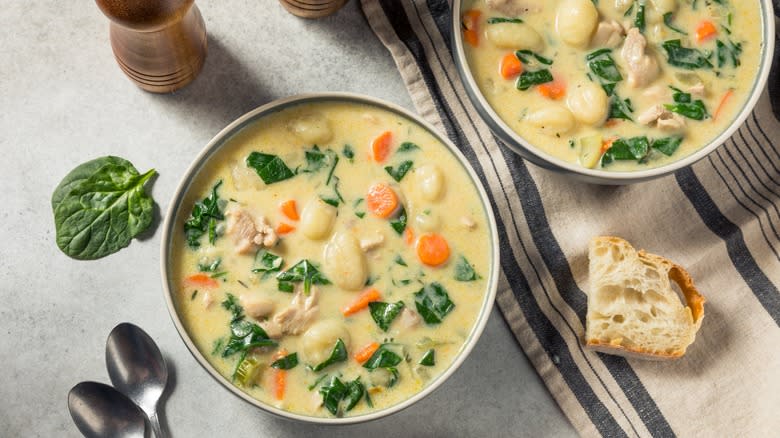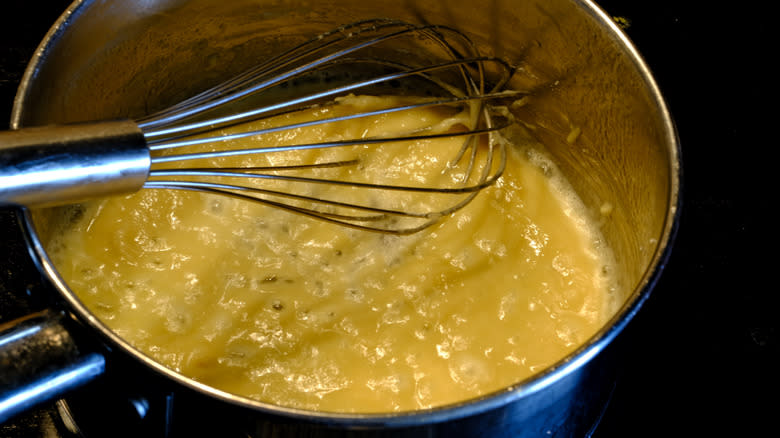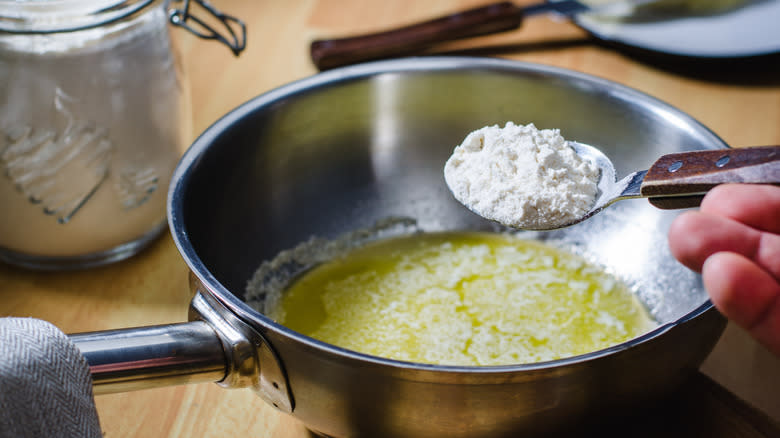Roux Is Key For A Hearty And Creamy Chicken Soup

We may receive a commission on purchases made from links.
When you're on the hunt for comfort food, light and fresh chicken soup might not cut it. What you want is something warm, rich, and creamy to fill you up — but even with the usual ingredients like milk or heavy cream, chicken soup won't always take on the thick and hearty quality you want. If you find your soup a little too runny or if you just need to elevate your chicken soup recipe, that's when it's time to turn to a culinary classic — roux.
A staple of soups, gravies, and gumbos, roux is a mixture of equal parts fat — like melted butter, oil, or lard — and flour. When heated in a pan on medium-high heat, the roux will get bubbly and become a paste. Just stir until the mixture is consistent and the right color (more on color to come), then you're ready to combine the roux with a liquid and add it to your chicken soup. The paste will thicken the soup to create a hearty, creamy consistency without a lot of extra time or hassle and the unappetizing clumps you'd get from adding straight flour.
Read more: 15 Tricks For Making The Most Crispy Chicken Thighs Ever
Cooking To The Right Color

In addition to eliminating flour's clumps, the roux's cooking process also removes any chalky taste, and a roux that's cooked for only about three to five minutes doesn't have much flavor on its own, just thickening properties. This is typically called white roux, and it's useful for dishes that have a lighter flavor and need something neutral like béchamel. If your creamy chicken soup has more mild ingredients, white roux won't overwhelm the rest of the dish.
The longer you cook the roux, though, the darker the color becomes and the more flavor it takes on. This process is called the Maillard reaction, a chemical reaction between amino acids and reducing sugars that happens when adding heat. The reaction gives a signature brown color and also imparts a toasty, nutty flavor and aroma. Light or blond roux (you might also see it called brown roux) is typically cooked for around seven minutes or until the roux turns a caramel color. It's generally used in gravies.
If you let your roux cook for closer to 15 minutes, it will become a chocolatey dark brown with a strong flavor and aroma. Dark roux is a crucial ingredient in gumbo. For a creamy chicken soup, white roux is the safest bet, but if you want to experiment with flavor or your recipe involves bolder, darker ingredients, it might pay to keep your roux on the stovetop a little longer.
Avoid These Roux Mistakes

Roux's cooking process is pretty straightforward, but it's also surprisingly easy to mess up. One of the frequent roux blunders is burning, so start with a heavier-bottomed pan, and don't rush the process by turning the heat up too high. If you're aiming for a dark brown roux, pick a fat other than butter because the longer cooking time will often lead to the butter burning. Regardless of the ingredients, whisk or stir the mixture frequently so that it doesn't stick to the bottom of the pan and start to scorch — this frequent and thorough whisking or stirring also combats the clumps of flour that might arise to ruin the batch.
Stick to the equal ratio of fat to flour, or your roux might be runny or too thick, neither of which will yield the paste your chicken soup recipe needs. Once you get that paste right and cook it just long enough that it's your desired color, gradually add a liquid (like stock or milk) before combining it with your soup. At this stage, it's important to allow the roux to cool slightly before you add the liquid, to use a cool or cold liquid, and to stir while you add it slowly lest the roux become clumpy.
If you watch the mixture carefully and keep to the right ratios, roux will become a signature ingredient. Master the art of roux, and your chicken soup will never be the same.
Read the original article on Daily Meal.